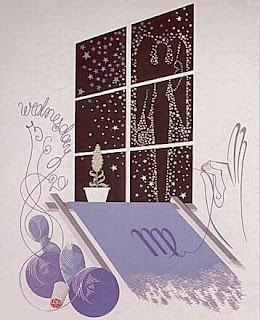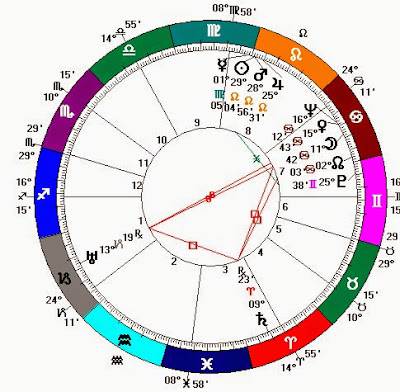I can never resist a dystopian tale, I haven't seen or read 'em all yet, but I'm getting there.
Code 46 , released in 2004, was a new one to me. I picked up the VHS tape in a junk store for $1 recently, we watched it on Friday evening. It's different overall, but still with a few similarities to other movies of its genre, and with a weird echo of a well-known Greek tragedy embedded.
Code 46 is a British written and directed movie, but doesn't come over as British in any way.
Michael Winterbottom directed, Frank Cottrell Boyce wrote the screenplay. They are both northern English guys, born in Blackburn and Liverpool respectively. (She chuckles)... the Beatles, from Liverpool, wrote about Blackburn, Lancashire once, remember:
I read the news today, oh boy
Four thousand holes in Blackburn, Lancashire
And though the holes were rather small
They had to count them all
Now they know how many holes it takes to fill the Albert Hall
But I digress.
I enjoyed
Code 46 but was left with numerous questions. I wish it had been a novel adaptation, so I could go read the detail I felt was missing in the film. As one reviewer wrote, "For at least half the movie, you need a code book a few inches thick to decipher
Code 46." That's exactly how I felt, but a novel would suffice.
Code 46 is set, we are led to believe, in the "near future". The impression I got was that the setting had to be much further ahead than "near" - at least 50 years or so ahead, maybe more. Budget restrictions probably dictated that background scenarios couldn't be CGI'd to appear much different from today - so what we have is the perception of simply more of the same, more of everything in cityscapes, less of everything outside of those.
The film's theme uses current issues, current fears, extrapolating them into a futuristic scenario which still looks uncomfortably familiar, but sounds odd. Dialogue is a mix of English with liberal splatterings of Spanish, French, Arabic and other languages. It's as though characters had swallowed several tourist phrase books!
Writer and director use the
Code 46 version of dystopia to highlight our well-known class struggles, cultural boundaries, personal identity crises and various "freedoms" or lack of them. It's clever and thought provoking - much more so than some other, high budget CGI-filled offerings.
In
Code 46's dystopic world cities are heavily controlled, accessible only through checkpoints. Outside of the cities we see only miles of desert wasteland and ragged struggling refugees eeking out an existence in shanty towns - people without papelles. "Papelles", a futuristic version of the passport/visa are essential for travel. Counterfeiting of these valuable items has been discovered and is the focus of an investigator's trip to Shanghai from the USA.

William, the investigator (Tim Robbins), has the advantage of using an "empathy virus" to enhance psychic insight and emotional sensitivities - and perhaps also, in the process, breaking down his learned societal inhibitions. He investigates a corporation, "Sphinx", where papelles are produced. He is able to identify the counterfeiter, Maria (Samantha Morton) quickly, then proceeds to have a love affair with her. He provides cover for Maria's crimes on his return to Seattle. Later, ordered to return to Shanghai, he discovers Maria has disappeared. He uses his authority to locate her in a medical facility, only to find that her memory of him, and their affair, has been "wiped".
Greek tragedy element coming up!
Maria had been pregnant, following the pair's brief affair. She had undergone a forced abortion and memory removal because, unknown to both of them, they are genetically related. Maria is a genetic clone of the investigator's mother, one of a set of 24 (I read this later in a synopsis). But why, I asked myself, would this future civilisation be cloning humans when the habitable areas of the planet seemed already overburdened with the natural variety? Anyway, Code 46 is the rule, or law, which states that genetically related humans must not be allowed to reproduce together, or even conduct relationships. That has been informal rule in our world for centuries. We, though, have always (or almost always) known exactly who are our close genetic relatives, thus avoiding problems arising from in-breeding. Cloning, especially if carried out in secret, could open a veritable Pandora's Box on this front.

The love story between William and Maria is the film's main theme. William is married, by the way, back in Seattle, with a young son. There was never going to be a happy ending for all. For more detail of the film's plot see Wikipedia's page linked at the top of the post.
Whether wholesale cloning, viruses designed to infect humans with such things as empathy or (another one mentioned in the film) rapid learning of a language, will be part of humanity's future remains to be seen by our youngest generation, or their kids and grandchildren. Life on a planet whose habitable surface has shrunk to a fraction of that we know, through climate change or war damage, or bio-hazards, yet still with technological know-how, lends itself to many scenarios, some of which have been explored already in novel and film. It's a never-ending source of fascination to me.
In closing, I feel like harking back to the Beatles. They were already mentioned, earlier, as the film screen-writer's fellow Liverpudlian Merseysiders. With no need for an empathy virus in 2014, most (not all) of us understand the deep-rooted truth which can soothe some weird and increasing feelings of dis-ease. The Beatles sang it for us, years ago:
"All you need is love".
RIP ~ Richard Attenborough. He died Sunday, aged 90. Below, in his part from one of my favouite movies
The Great Escape. I think all the Great Escapers are gone now - the greatest escape of all, one could say; some went long ago, some more recently.






































 Below is the natal chart of Julian Assange constructed from data available. His date and place or birth are said to have been taken from official documents, so ought to be reliable. Even so, I retain a wee bit of doubt, he being in the business he's in! The birth time is the most open to question, but as it's the only one available I've included it below.
Below is the natal chart of Julian Assange constructed from data available. His date and place or birth are said to have been taken from official documents, so ought to be reliable. Even so, I retain a wee bit of doubt, he being in the business he's in! The birth time is the most open to question, but as it's the only one available I've included it below.























